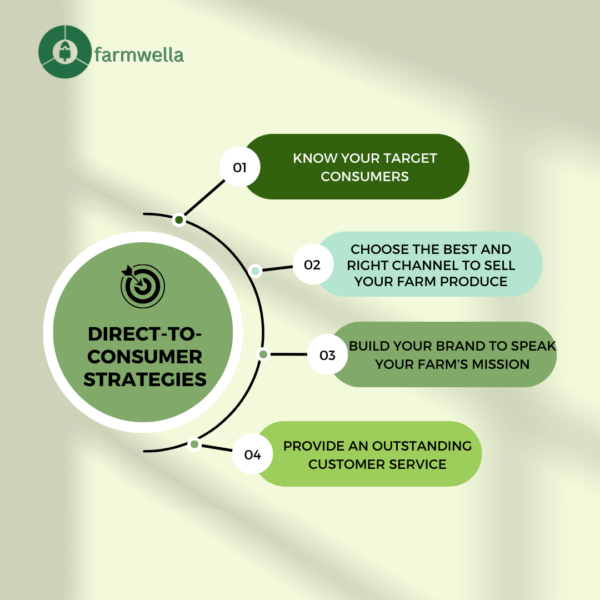It can be challenging for farmers, especially small-scale farmers, to make significant profits from their farm produce because there are many intermediaries involved in the supply chain.
In fact, a study shows that intermediaries can affect how much money farmers make. Even if farmers use e-intermediaries, they may not make enough money if the supply chain is too broken up.
This means that farmers need to have a strong position in the market, not just access to it.

However, there is an effective approach that has been proven to work: direct-to-consumer marketing.
So what exactly is direct-to-consumer marketing? It’s simply selling products directly to customers without going through middlemen like wholesalers or retailers.
Direct-to-consumer marketing is packed with benefits for small-scale farmers. In this article, we’ll delve into some of these benefits and their impact on the industry. Additionally, we will discuss strategies for successfully implementing direct-to-consumer marketing to increase your farm’s profitability.
How direct-to-consumer marketing can impact your overall farm marketing
Let’s explore some of the changes and impacts that direct-to-consumer marketing can have on your overall farm marketing.
1. Expands the farmers' access to customers
With direct-to-consumer marketing, farmers have the opportunity to connect with consumers directly. This allows them to understand the consumers’ needs and preferences and to make improvements to their farm produce accordingly. Unlike when retailers and wholesalers are the middlemen, farmers now have direct access to consumers, which can help them strengthen their relationships with consumers.
2. Farmers can have authority over the cost of their agricultural products
Farmers can now have more say in the pricing of their farm produce. In the past, middlemen like retailers and wholesalers would determine the prices, which sometimes resulted in lower profits for the farmers. But with direct-to-consumer marketing, farmers can set prices that are more favorable for their business.
3. Leads to higher profits for farmers
When farmers sell their farm produce directly to consumers, they don’t have to involve middlemen, which means they can earn more profit.
This doesn’t necessarily mean that farmers have to raise their prices, but rather, they get to keep the profits that would have gone to the middlemen. By cutting out the middlemen, farmers can put more money in their pockets and reinvest in their farms to improve their produce even further.
4. More authority over the quality of the products
When farmers sell their produce through traditional channels like wholesalers and retailers, they have less control over the quality of their products. But, with direct-to-consumer marketing, farmers have more power to ensure that their products are of the best quality.
Farmers can directly communicate with their customers and get feedback about their products, which helps them to improve the quality and tailor their products to their customers’ preferences.
This way, customers receive high-quality, fresh products directly from the farmer, and farmers can establish a reputation for providing top-notch produce.
How to carry out a successful direct-to-consumer marketing
Direct-to-consumer marketing may be unfamiliar to many farmers who are used to relying on intermediaries. However, learning how to carry out this type of marketing can significantly increase productivity and profitability. Let’s explore some practical steps that small-scale farmers can take to successfully implement direct-to-consumer marketing.

Know your target consumers
As a small-scale farmer, it’s important to know your target consumers before embarking on a direct-to-consumer marketing campaign.
Knowing your target market means identifying the group of people who are most likely to buy your products. You can conduct market research to understand the demographics and preferences of your potential customers.
To get started, consider the following questions:
- Who is your ideal customer? What are their interests, preferences, and values?
- What value can you offer that is different from what they have been getting in the past?
- Where do they live? Are they urban or rural consumers?
- What is their income level? Are they willing to pay a premium for locally sourced products?
- What are their shopping habits? Do they prefer to buy from farmers’ markets or online?
Once you have a better understanding of your target consumers, you can tailor your marketing strategy to meet their needs and preferences. This can help you create a stronger connection with your customers and increase sales.
Choose the best channel to sell your farm produce
Choosing the right sales channels is crucial to the success of your direct-to-consumer marketing strategy. You need to ensure that your products are reaching the right customers in the most efficient way possible.
One option is to sell your products at farmers’ markets, where you can connect with customers face-to-face and build relationships with them.
Another option is to participate in community-supported agriculture (CSA) programs, where customers pay upfront for a share of your harvest throughout the season. This allows you to plan ahead and have a reliable customer base.
In recent years, online stores have also become a popular sales channel for direct-to-consumer marketing. By setting up an online store, you can reach a wider audience and sell your products 24/7. However, it is important to note that online sales require a strong online presence and effective marketing strategies.
In a nutshell, the key is to choose the sales channels that work best for your target audience and align with your farm’s capabilities and resources.
Build your brand to speak your farm’s mission
Your brand should represent your farm’s values, mission, and unique selling proposition.
To start, make sure you create a brand name, a logo, and packaging that stands out and catches the eye of potential customers.
In addition to these visual elements, consider the overall experience that customers will have when interacting with your brand.
For example, you can offer exceptional customer service, create a user-friendly website, and develop engaging social media content that reflects your brand’s personality.
This will ultimately lead to your brand gaining more recognition.
Provide an outstanding customer service
Providing excellent customer service is essential for the success of direct-to-consumer marketing. As a small-scale farmer, it is essential to build positive relationships with your customers to encourage repeat business and referrals.
To provide excellent customer service, you must respond promptly to customer inquiries and feedback. You can also offer high-quality products that meet or exceed customer expectations. Additionally, you should offer flexible payment and delivery options that meet the needs of your customers.
One way to provide excellent customer service is to engage with your customers directly. When selling at farmers’ markets or other local events, take the time to talk to customers and answer their questions. This can ultimately lead to an established trust and loyalty with your customers.
You can also go the extra mile by offering value-added services such as recipe ideas, cooking tips, or workshops on sustainable farming practices.
In a nutshell
Making a profit is a key goal for any business, and farming is no exception. Therefore, it is crucial to use effective marketing strategies that benefit farmers as a community. After all, farmers work hard to provide us with the food we need to survive, and it’s only fair that they earn a reasonable income from their labor.
